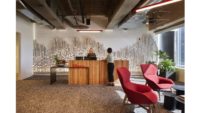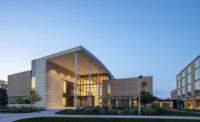LMN Architects is pleased to celebrate the design and construction of the new Seattle Aquarium Ocean Pavilion. The project is the first substantial addition to the Aquarium since 2007. The new construction includes 50,000 square feet of immersive living exhibits, back-of-house elements, theatrical spaces and views of the surrounding natural landscape and the urban waterfront.
Guided by the mission to inspire conservation of the marine environment, the Seattle Aquarium Ocean Pavilion will integrate a complex building program focused on public engagement into Seattle’s new central waterfront. The Ocean Pavilion joins the existing Aquarium facilities that occupy Piers 59 and 60 to create a new sustainable campus of Aquarium places. This network of buildings and the new Pavilion create an engaging human environment linking the city, waterfront and ocean.
“This network of buildings and the new Seattle Aquarium Ocean Pavilion represents what is possible when the local community and a multidisciplinary team collaborate in support of a shared vision of public life and a conservation mission,” said Mark Reddington, Partner at LMN Architects. “The project has been guided by a desire to design a ‘waterfront for all’ serving the Seattle community. This design has been developed around ideas of creating a network of accessible, inclusive connections linking the city, the waterfront and the ocean, integrated with interior and exterior experiences of the Ocean Pavilion.”
The project integrates the public realm and Aquarium exhibit experiences in an extroverted gesture to public engagement. A series of public pathways provide vertical connections between multiple levels of public plazas, woven together by interpretive NW native gardens and public gathering spaces. The plazas will be part of a network of new open spaces along the waterfront and adjacent to the new Overlook Walk designed by the City of Seattle Office of the Waterfront, James Corner Field Operations, Miller Hull and Jacobs.
The building is organized with an urban edge, highlighting the back-of-house support systems for the Ocean Pavilion. It relates these technical operations to the surrounding neighborhood’s light industrial and commercial activities. The Pavilion’s west side gestures to the waterfront, with sweeping geometries and a series of views providing a connection to the Salish Sea and beyond. Strategically placed glazing provides equitable opportunities for the public to see into the Pavilion’s interior and engage with the activities inside of the Aquarium, including an iconic Oculus, offering public views into the main reef ecosystem exhibit.
The Ocean Pavilion is an armature for immersive living exhibits, ecological experiences, exposed back-of-house elements, theatrical spaces and hands-on exploration. It includes well-placed views of the surrounding landscape and urban waterfront, which connect local stories to the interpretive experiences. Within this context, the design moves away from the traditional “theater of ecosystems” model of aquarium design and acknowledges the rich interplay between human life and ocean life, while offering a working model of a thriving human culture that fosters a prosperous marine environment and ocean ethic. The central exhibit in the Pavilion will be a 325,000-gallon reef ecosystem that underscores the importance of predators in a healthy marine ecosystem and features more than 120 species of fish and invertebrates. Circulation pathways winding through the Pavilion’s levels offer a variety of above- and below-water views of exhibits, as well as views to the Aquarium Plaza and waterfront. To visibly honor and acknowledge the Aquarium’s location on the traditional lands of the Coast Salish peoples, the project team worked closely with local tribes and Indigenous communities to inform and shape the programming, design and cultural framework for the building, landscape, exhibits and public art. Engagement included hearing traditional stories from tribal elders, workshops with tribal youth and regular design sessions with Indigenous consultants.
Sustainability is one of the core institutional values of the Seattle Aquarium. The Ocean Pavilion will amplify the Seattle Aquarium’s mission through sustainable solutions that focus on key principles like the health of local and Indo-Pacific ecosystems, climate change, ocean acidification and resiliency, all of which are prioritized through an equity and social justice lens. These strategies include the use of non-toxic, ecologically restorative materials, electrification and the elimination of fossil fuels, embodied carbon reduction and heat sharing between the life support and building systems.
“The project team was deliberate in material choices for construction of the building by minimizing plastics, vinyls, biocides and red-list materials throughout,” said Osama Quotah, Partner at LMN Architects. “We analyzed embedded carbon in the project, making material choices that minimize their carbon footprint. Overall, the project is targeting net-zero carbon and net-zero energy, and the project team continues to study aggressive targets and strategies around energy and carbon that can be implemented at the larger campus scale.”
Project construction includes the sequencing and detailed coordination of three project construction schedules. This work includes the Seattle Aquarium Ocean Pavilion, the City’s Overlook Walk project and the City’s Main Corridor project. The construction of Ocean Pavilion is underway and is expected to conclude in 2024. Construction milestones that will be achieved this year are completion of the shell, core and roof, main exhibit form, habitat structures and installation of the habitat acrylic windows and animal life support systems.
“The site of the Seattle Aquarium Ocean Pavilion is a prominent place in the new waterfront where the waterfront public spaces, the connection to Pike Place Market and proximity to the Salish Sea intersect,” Reddington said. “It is a place of importance in the urban framework. The Ocean Pavilion, as the connecting piece in this location, demonstrates Seattle’s commitment to fighting climate change. At a time when the world is struggling with massive environmental challenges, and when Seattle is transforming its central waterfront to be integrated with the ecology of the ocean, this project capitalizes on that convergence to elevate the public experience, understanding and support for the health of the world’s ocean.”









